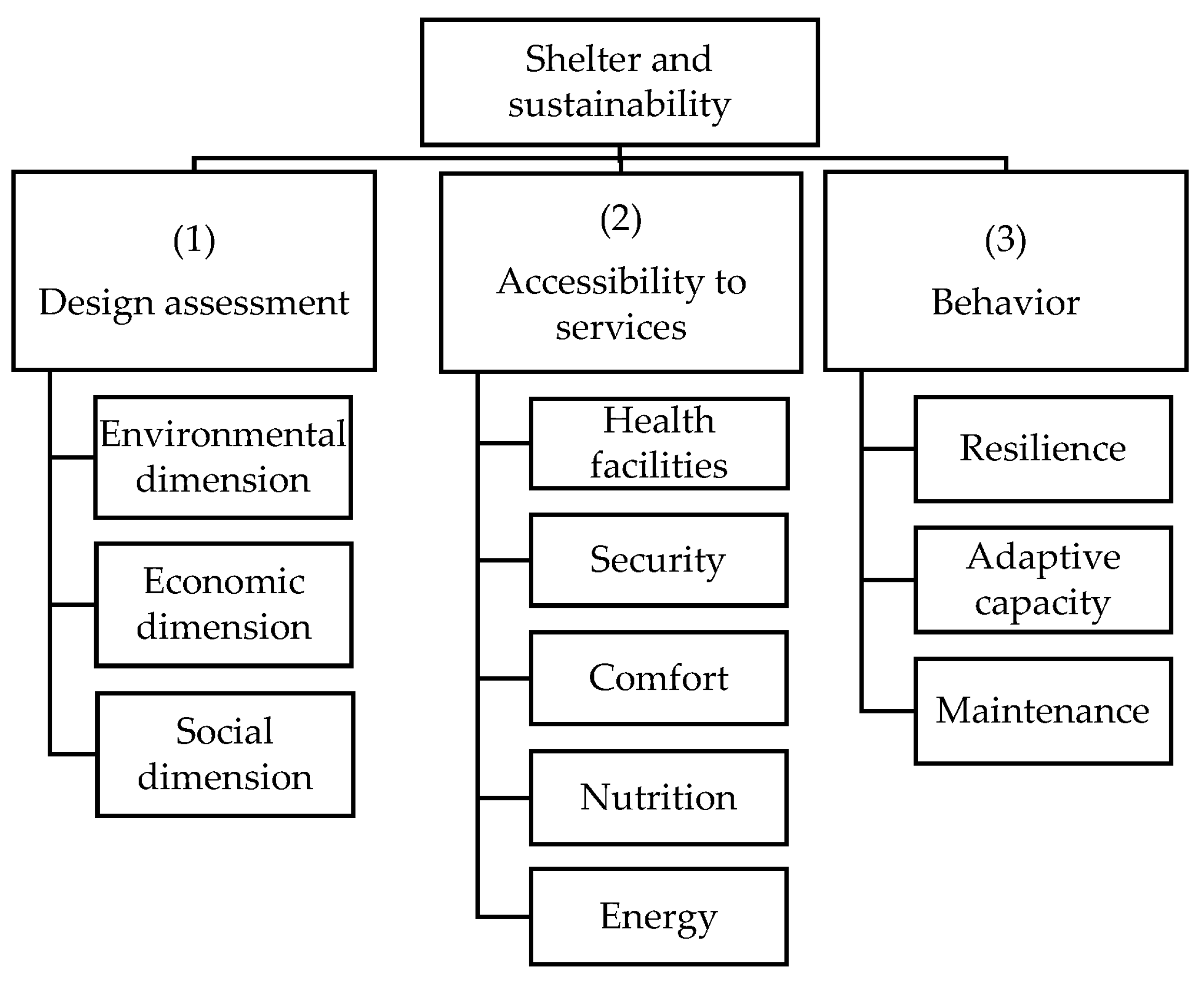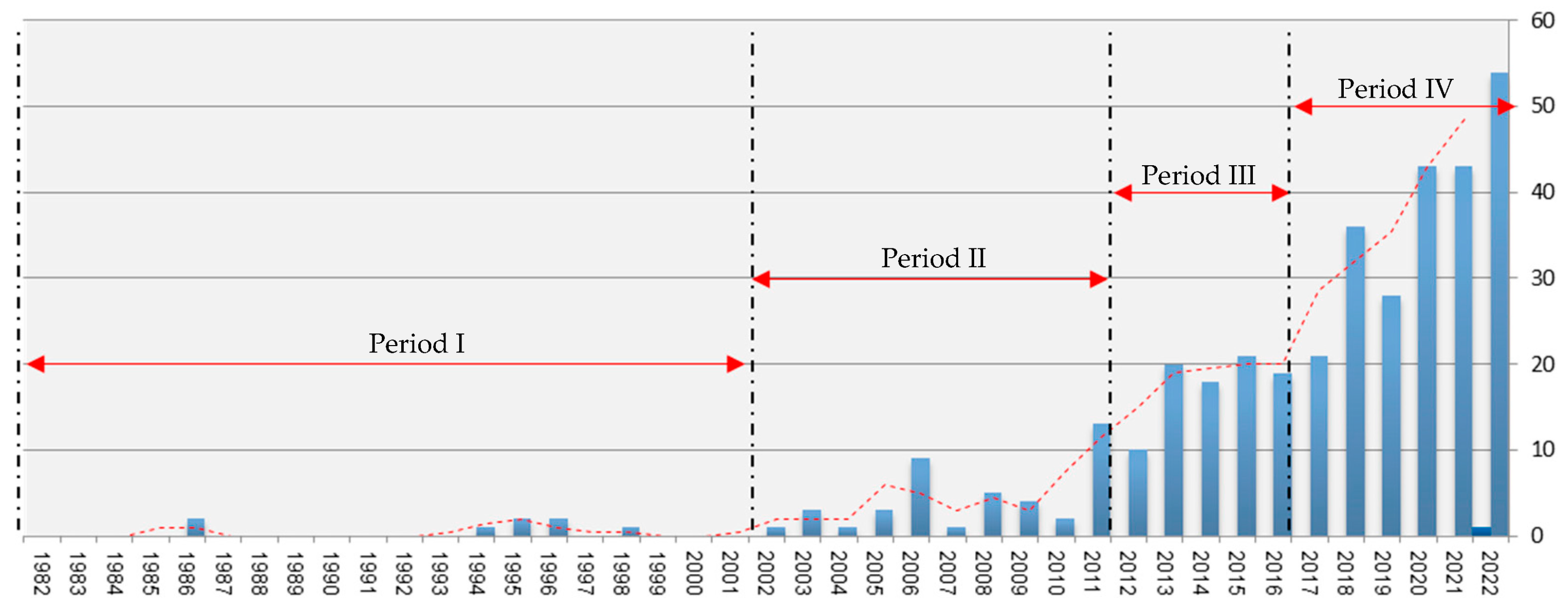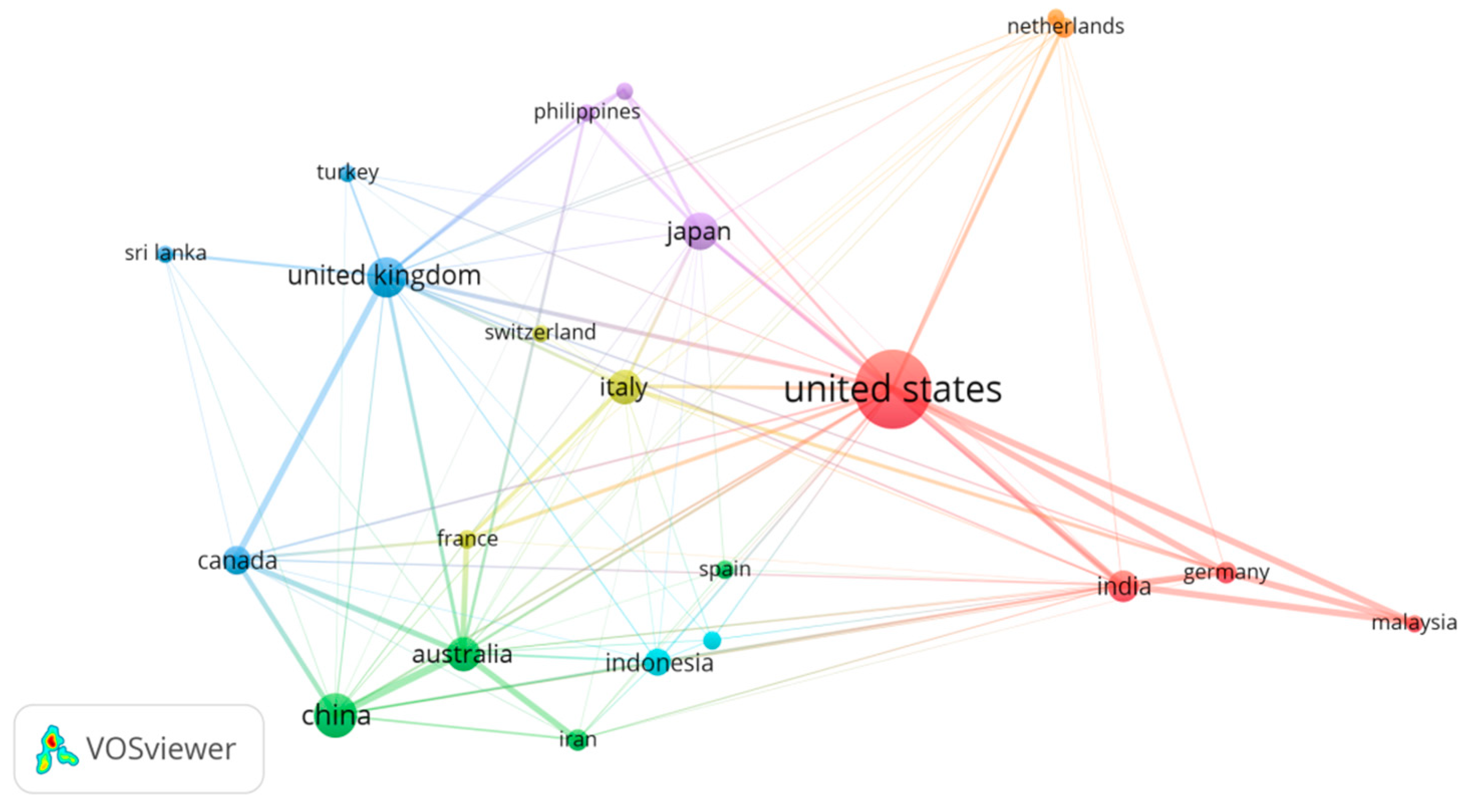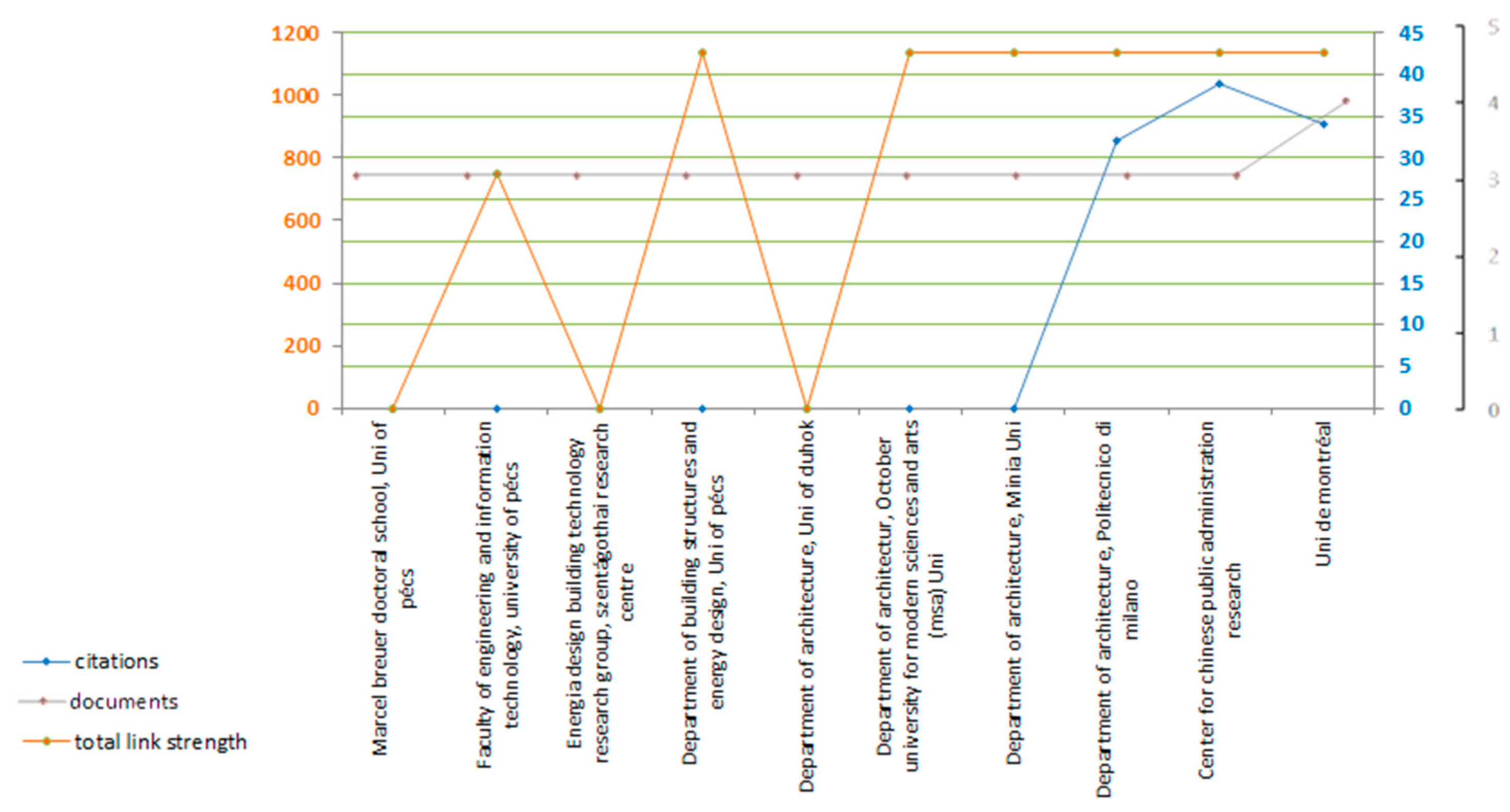Sustainability Trends in Humanitarian Architecture Research: A Bibliometric Analysis
Abstract
1. Introduction
2. Materials and Methods
2.1. Selection of Database
2.2. Identification of Search Keywords
2.3. Search and Selection of Documents Criteria
2.4. Selection of Data Extraction Software
2.5. Data Analysis
3. Results
3.1. Literature Development Trend
3.2. Keywords Hotness Analysis
3.2.1. Co-Occurrences of Keyword Networks
3.2.2. Evolution of sustainability and PDPC shelter topic
3.3. Source Distribution of Publications
3.4. Country and Research Institute Analysis
3.5. Top Cited Articles and Most Productive Authors
4. Discussions
4.1. Temporal Trends
4.2. Gaps
5. Conclusions
- USA, China, United Kingdom, and Japan dominate the publication production in the researched area as countries;
- The analysis did not find a specific organization that stands out in the field of sustainable PDPC shelters research, but it was found that most of the involved organizations operate in the fields of architecture and civil and environmental engineering;
- Co-authorship Analysis identified 1092 authors who contributed to the literature in the field, of whom 12 had provided at least four papers;
- According to the keyword analysis, most research outputs which were conducted prior to 2012 had concentrated on disaster preparedness, healthcare, and environmental design and management. Studies in recent years begin to address sustainable design and eco-design aspects, but with a higher association with shelter design and planning;
- Generally, the link between the engaged institutions in research is relatively weak. It can be noted that most active institutions were universities and research centers and, therefore, lacked the extensive collaboration with stakeholders, non-governmental organizations, and governmental entities that generate shelter responses.
Supplementary Materials
Author Contributions
Funding
Institutional Review Board Statement
Informed Consent Statement
Data Availability Statement
Conflicts of Interest
References
- Shahid, M. What History Can Teach Us about Sustainable Architecture. 2022. Available online: https://www.re-thinkingthefuture.com/history-of-architecture/a2906-what-history-can-teach-us-about-sustainable-architecture/ (accessed on 8 November 2022).
- SAUS. Climate Architecture and Sustainable Architecture. 3 December 2022. Available online: https://sauc.ir/en/history-of-sustainable-architecture/ (accessed on 12 December 2022).
- Haapio, A.; Viitaniemi, P. A critical review of building environmental assessment tools. Environ. Impact Assess. Rev. 2008, 28, 469–482. [Google Scholar] [CrossRef]
- Sphere, P. Sphere Handbook: Humanitarian Charter and Minimum Standards in Disaster Response; The sphere project. 2018; Practical Action Pub: Geneva, Switzerland, 2018; Available online: www.spherestandards.org/handbook/ (accessed on 12 November 2022).
- Alshawawreh, L.; Pomponi, F.; D’amico, B.; Snaddon, S.; Guthrie, P. Qualifying the Sustainability of Novel Designs and Existing Solutions for Post-Disaster and Post-Conflict Sheltering. Sustainability 2020, 12, 890. [Google Scholar] [CrossRef]
- Fosas, D.; Albadra, D.; Natarajan, S.; Coley, D.A. Refugee housing through cyclic design. Arch. Sci. Rev. 2018, 61, 327–337. [Google Scholar] [CrossRef]
- Ramboll & Save the Children. Shelter Innovations Workshop–Conclusions and Recommendations. 2017. Available online: https://uk.ramboll.com/-/media/files/ruk/2_sectors-and-services-brochures/buildings/shelterworkshop-a5-leaflet-06-2017-final-hi-res.pdf/ (accessed on 15 December 2022).
- Albadra, D.; Coley, D.; Hart, J. Toward healthy housing for the displaced. J. Arch. 2018, 23, 115–136. [Google Scholar] [CrossRef]
- Bashawri, A.; Garrity, S.; Moodley, K. An Overview of the Design of Disaster Relief Shelters. Procedia Econ. Financ. 2014, 18, 924–931. [Google Scholar] [CrossRef]
- Salas-Zapata, W.A.; Ortiz-Muñoz, S.M. Analysis of meanings of the concept of sustainability. Sustain. Dev. 2019, 27, 153–161. [Google Scholar] [CrossRef]
- Estoque, R.C.; Murayama, Y. Measuring Sustainability Based Upon Various Perspectives: A Case Study of a Hill Station in Southeast Asia. AMBIO 2014, 43, 943–956. [Google Scholar] [CrossRef]
- Elkington, J. Towards the Sustainable Corporation: Win-Win-Win Business Strategies for Sustainable Development. Calif. Manag. Rev. 1994, 36, 90–100. [Google Scholar] [CrossRef]
- Jeurissen, R. John Elkington, Cannibals With Forks: The Triple Bottom Line of 21st Century Business. Altern. J. 2019, 25, 42. [Google Scholar] [CrossRef]
- Escamilla, E.Z.; Habert, G.; Muñoz, L.L.; Göswein, V.; Venzi, M. What to build after disaster?: Sustainability assessment of twenty post-disaster shelters designs. In Proceedings of the World Sustainable Building 2014 Barcelona Conference, Barcelona, Spain, 28–30 October 2014. [Google Scholar] [CrossRef]
- Mateus, R.; Bragança, L. Sustainability assessment and rating of buildings: Developing the methodology SBToolPT–H. Build. Environ. 2011, 46, 1962–1971. [Google Scholar] [CrossRef]
- ShelterCluster. Pilots Sustainable Shelter Solutions. 12 November 2022. Available online: https://sheltercluster.org/working-group/pilots-sustainable-shelter-solutions (accessed on 13 January 2023).
- UNHCR and UN-Habitat. The Right to Adequate Housing; UNHCR and UN-Habitat: Geneva, Switzerland, 2014; p. 8. [Google Scholar]
- IFRC. Introduction to Disaster Preparedness; IFRC: Geneva Switzerland, 2000. [Google Scholar]
- BREGlobal. Quantifying Sustainability in the Aftermath of Natural Disasters; BREGlobal: Watford, UK, 2014. [Google Scholar]
- Tayfur, I.; Günaydin, M.; Suner, S. Healthcare Service Access and Utilization among Syrian Refugees in Turkey. Ann. Glob. Health 2019, 85, 1–6. [Google Scholar] [CrossRef] [PubMed]
- Chalamwong, Y.; Thabchumpon, N.; Chantavanich, S. Temporary Shelters and Surrounding Communities: Livelihood Opportunities, The Labour Market, Social Welfare and Social Security; Springer Science & Business Media: New York, NY, USA, 2013; Volume 15. [Google Scholar]
- Cobo, M.J.; López-Herrera, A.G.; Herrera-Viedma, E.; Herrera, F. Science mapping software tools: Review, analysis, and cooperative study among tools. J. Am. Soc. Inf. Sci. Technol. 2011, 62, 1382–1402. [Google Scholar] [CrossRef]
- Waltman, L.; van Eck, N.J.; Noyons, E.C.M. A unified approach to mapping and clustering of bibliometric networks. J. Informetr. 2010, 4, 629–635. [Google Scholar] [CrossRef]
- Liu, X.; Zhang, J.; Guo, C. Full-text citation analysis: A new method to enhance scholarly networks. J. Am. Soc. Inf. Sci. Technol. 2013, 64, 1852–1863. [Google Scholar] [CrossRef]
- Scopus. Coverage You Can Count on. 2022. Available online: https://www.elsevier.com/solutions/scopus/how-scopus-works/content?dgcid=RN_AGCM_Sourced_300005030 (accessed on 23 February 2023).
- Elsevier, S. Scopus Content Coverage Guide; Elsevier BV: Amsterdam, The Netherlands, 2020; Volume 2, pp. 947–955. [Google Scholar]
- IFRC. Post-Disaster Shelter: Ten Designs; IFRC: Geneva Switzerland, 2013. [Google Scholar]
- Yang, Y.; Reniers, G.; Chen, G.; Goerlandt, F. A bibliometric review of laboratory safety in universities. Saf. Sci. 2019, 120, 14–24. [Google Scholar] [CrossRef]
- Van Eck, N.J.; Waltman, L. Visualizing bibliometric networks. In Measuring Scholarly Impact; Springer: Cham, Switzerland, 2014; pp. 285–320. [Google Scholar] [CrossRef]
- Zupic, I.; Čater, T. Bibliometric methods in management and organization. Organ. Res. Methods 2015, 18, 429–472. [Google Scholar] [CrossRef]
- del Río-Rama, M.D.L.C.; Maldonado-Erazo, C.P.; Álvarez-García, J.; Durán-Sánchez, A. Cultural and natural resources in tourism Island: Bibliometric mapping. Sustainability 2020, 12, 724. [Google Scholar] [CrossRef]
- Donthu, N.; Kumar, S.; Mukherjee, D.; Pandey, N.; Lim, W.M. How to conduct a bibliometric analysis: An overview and guidelines. J. Bus. Res. 2021, 133, 285–296. [Google Scholar] [CrossRef]
- Tobin, G.A.; Whiteford, L.M. Community resilience and volcano hazard: The eruption of Tungurahua and evacuation of the faldas in Ecuador. Disasters 2002, 26, 28–48. [Google Scholar] [CrossRef]
- Lane, K.; Charles-Guzman, K.; Wheeler, K.; Abid, Z.; Graber, N.; Matte, T. Health Effects of Coastal Storms and Flooding in Urban Areas: A Review and Vulnerability Assessment. J. Environ. Public Heal. 2013, 2013, 1–13. [Google Scholar] [CrossRef]
- Kuwabara, H.; Shioiri, T.; Toyabe, S.-I.; Kawamura, T.; Koizumi, M.; Ito-Sawamura, M.; Akazawa, K.; Someya, T. Factors impacting on psychological distress and recovery after the 2004 Niigata-Chuetsu earthquake, Japan: Community-based study. Psychiatry Clin. Neurosci. 2008, 62, 503–507. [Google Scholar] [CrossRef] [PubMed]
- Kun, P.; Tong, X.; Liu, Y.; Pei, X.; Luo, H. What are the determinants of post-traumatic stress disorder: Age, gender, ethnicity or other? Evidence from 2008 Wenchuan earthquake. Public Health 2013, 127, 644–652. [Google Scholar] [CrossRef] [PubMed]
- Christian, M.D.; Devereaux, A.V.; Dichter, J.R.; Rubinson, L.; Kissoon, N. Introduction and Executive Summary: Care of the critically ill and injured during pandemics and disasters: CHEST consensus statement. Chest 2014, 146, 8S–34S. [Google Scholar] [CrossRef] [PubMed]
- Gorman-Murray, A.; McKinnon, S.; Dominey-Howes, D. Queer domicide: LGBT displacement and home loss in natural disaster impact, response, and recovery. Home Cult. 2014, 11, 237–261. [Google Scholar] [CrossRef]
- Adeola, F.O. Katrina cataclysm: Does duration of residency and prior experience affect impacts, evacuation, and adaptation behavior among survivors? Environ. Behav. 2009, 41, 459–489. [Google Scholar] [CrossRef]
- Amaratunga, D.; Haigh, R. Post-Disaster Reconstruction of the Built Environment: Rebuilding for Resilience; John Wiley & Sons: Hoboken, NJ, USA, 2011. [Google Scholar]
- Arslan, H.; Cosgun, N. Reuse and Recycle Potentials of the Temporary Houses after Occupancy: Example of Duzce, Turkey. Build. Environ. 2008, 43, 702–709. [Google Scholar] [CrossRef]
- Zhao, L.; Li, H.; Sun, Y.; Huang, R.; Hu, Q.; Wang, J.; Gao, F. Planning Emergency Shelters for Urban Disaster Resilience: An Integrated Location-Allocation Modeling Approach. Sustainability 2017, 9, 2098. [Google Scholar] [CrossRef]
- Istiadji, A.D.; Hardiman, G.; Satwiko, P. What is the sustainable method enough for our built environment? IOP Conf. Series Earth Environ. Sci. 2018, 213, 012016. [Google Scholar] [CrossRef]
- Conzatti, A.; Kershaw, T.; Copping, A.; Coley, D. A review of the impact of shelter design on the health of displaced populations. J. Int. Humanit. Action 2022, 7, 18. [Google Scholar] [CrossRef]
- WHO. Guide to Sanitation in Natural Disasters; WHO: Geneva Switzerland, 1971; p. 36. [Google Scholar]
- TheSphereProject. Humanitarian Charter and Minimum Standards in Humanitarian Response; Belmont Press Ltd.: Northampton, UK, 2011. [Google Scholar]
- ShelterProjects. The History of Three Point Five Square Metres; ShelterProjects: Blackburn, UK, 2011. [Google Scholar]
- Estoque, R.C. A Review of the Sustainability Concept and the State of SDG Monitoring Using Remote Sensing. Remote. Sens. 2020, 12, 1770. [Google Scholar] [CrossRef]
- Lettieri, E.; Masella, C.; Radaelli, G. Disaster management: Findings from a systematic review. Disaster Prev. Manag. Int. J. 2009, 18, 117–136. [Google Scholar] [CrossRef]
- Hellweg, S.; Milà i Canals, L. Emerging approaches, challenges and opportunities in life cycle assessment. Science 2014, 344, 1109–1113. [Google Scholar] [CrossRef] [PubMed]
- Eck Nees, J.; Waltman, L. Manual for VOSviewer Version 1.6.8; CWTS Meaningful Metrics; Universiteit Leiden: Leiden, The Netherlands, 2018; p. 25. [Google Scholar]
- Jan, A.A.; Lai, F.-W.; Siddique, J.; Zahid, M.; Ali, S.E.A. A walk of corporate sustainability towards sustainable development: A bibliometric analysis of literature from 2005 to 2021. Environ. Sci. Pollut. Res. 2023, 30, 36521–36532. [Google Scholar] [CrossRef] [PubMed]
- Kargin, I.A. The unending Arab Spring in Syria: The primary dynamics of the Syrian civil war as experienced by Syrian refugees. Turk. Stud. 2018, 13, 27–48. [Google Scholar] [CrossRef]
- IDMC. New Displacement by Conflict and Disasters in 2017; IDMC: Geneva Switzerland, 2017. [Google Scholar]
- Montesi, M.; Owen, J.M. From conference to journal publication: How conference papers in software engineering are extended for publication in journals. J. Am. Soc. Inf. Sci. Technol. 2008, 59, 816–829. [Google Scholar] [CrossRef]










| Boolean Logical Expression | ||||||
|---|---|---|---|---|---|---|
| 1 | sustainability OR sustainable | AND | “emergency shelter” OR “temporary shelter” OR “transitional shelter” OR “progressive shelter” OR “core shelter” | AND PUBYEAR > 1981 | AND (LIMIT-TO (LANGUAGE, “English” | 101 |
| 2 | access AND (health OR security OR comfort OR nutrition OR energy) | 79 | ||||
| 3 | “sustainability” AND (“assessment” OR “indicator *” | 13 | ||||
| 4 | resilien * OR Adapt * OR mainten * | 172 | ||||
| Total | 365 | |||||
| Source | Documents | Citations * | Impact factor in 2021 |
|---|---|---|---|
| International Journal of Disaster Risk Reduction | 16 | 163 | 4.842 |
| Sustainability (Switzerland) | 11 | 93 | 3.889 |
| Disasters | 9 | 312 | 3.311 |
| International Journal of Environmental Research and Public Health | 7 | 75 | 4.614 |
| Disaster Medicine and Public Health Preparedness | 5 | 32 | 2.75 |
| IOP conference series: Materials Science And Engineering | 5 | 9 | ------ |
| Lecture notes in civil engineering | 5 | 2 | 0.133 |
| PLOS One | 5 | 83 | 3.752 |
| Safety Science | 5 | 81 | 6.50 |
| International Journal of Disaster Resilience in the Built Environment | 4 | 14 | 1.32 |
| Title | Authors | Citations * | Source | |
|---|---|---|---|---|
| 1 | Community Resilience and Volcano Hazard: The Eruption of Tungurahua and Evacuation of the Faldas in Ecuador | Graham A. Tobin, Linda M. Whiteford [33] | 153 | Disasters |
| 2 | Health Effects of Coastal Storms and Flooding in Urban Areas: A Review and Vulnerability Assessment | Kathryn Lane, Kizzy Charles-Guzman [34] | 124 | Journal of Environmental and Public Health |
| 3 | Factors impacting on psychological distress and recovery after the 2004 Niigata–Chuetsu earthquake, Japan: Community-based study | Hideki Kuwabara md, Toshiki Shioiri [35] | 80 | PCN |
| 4 | What are the determinants of post-traumatic stress disorder: age, gender, ethnicity or other? Evidence from 2008 Wenchuan earthquake | P.KunaX, TongbY, Liua [36] | 79 | Public health |
| 5 | Introduction and Executive SummaryCare of the Critically Ill and Injured During Pandemics and Disasters: CHEST Consensus Statement | Michael D. Christian, Asha V. Devereaux [37] | 67 | CHEST |
| 6 | Queer Domicide: LGBT Displacement and Home Loss in Natural Disaster Impact, Response, and Recovery | Andrew Gorman-Murray, Scott McKinnon, Dale Dominey-Howes [38] | 63 | Home Cultures |
| 7 | Katrina Cataclysm: Does Duration of Residency and Prior Experience Affect Impacts, Evacuation, and Adaptation Behavior Among Survivors? | Francis O. Adeola [39] | 60 | Environment and Behavior |
| 8 | Post-Disaster Reconstruction of the Built Environment: Rebuilding for Resilience | Dilanthi Amaratunga, Richard Haigh [40] | 54 | ----- |
| 9 | Reuse and recycle potentials of the temporary houses after occupancy: Example of Duzce, Turkey | Hakan Arslan, Nilay Cosgun [41] | 53 | Energy and Buildings |
| 10 | Planning Emergency Shelters for Urban Disaster Resilience: An Integrated Location-Allocation Modeling Approach | Laijun Zhao, Huiyong Li [42] | 46 | Sustainability (Switzerland) |
Disclaimer/Publisher’s Note: The statements, opinions and data contained in all publications are solely those of the individual author(s) and contributor(s) and not of MDPI and/or the editor(s). MDPI and/or the editor(s) disclaim responsibility for any injury to people or property resulting from any ideas, methods, instructions or products referred to in the content. |
© 2023 by the authors. Licensee MDPI, Basel, Switzerland. This article is an open access article distributed under the terms and conditions of the Creative Commons Attribution (CC BY) license (https://creativecommons.org/licenses/by/4.0/).
Share and Cite
Kwaylih, A.; Alshawawreh, L.; Pomponi, F. Sustainability Trends in Humanitarian Architecture Research: A Bibliometric Analysis. Sustainability 2023, 15, 11430. https://doi.org/10.3390/su151411430
Kwaylih A, Alshawawreh L, Pomponi F. Sustainability Trends in Humanitarian Architecture Research: A Bibliometric Analysis. Sustainability. 2023; 15(14):11430. https://doi.org/10.3390/su151411430
Chicago/Turabian StyleKwaylih, Anwar, Lara Alshawawreh, and Francesco Pomponi. 2023. "Sustainability Trends in Humanitarian Architecture Research: A Bibliometric Analysis" Sustainability 15, no. 14: 11430. https://doi.org/10.3390/su151411430
APA StyleKwaylih, A., Alshawawreh, L., & Pomponi, F. (2023). Sustainability Trends in Humanitarian Architecture Research: A Bibliometric Analysis. Sustainability, 15(14), 11430. https://doi.org/10.3390/su151411430







